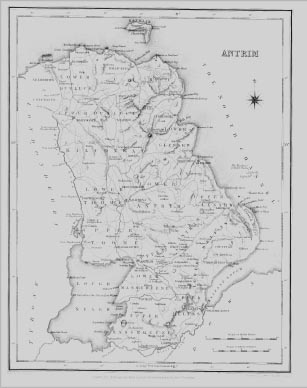| Accompanying Lewis map for Antrim 
|
| MASSEREENE |
| MASSEREENE, a village, in the grange of MUCKAMORE, barony of LOWER MASSEREENE, county of ANTRIM, and province of ULSTER, contiguous to the town of Antrim ; containing 319 inhabitants. This place is situated on the Six-Mile-water, by which it is separated from Antrim ; and though now only a small village, forming a suburb to that town, it is the head of, and gives name to, one of the largest and most fertile baronies in the county. In 1426, a priory for Franciscan friars was founded here by one of the O'Nial family, which, in 1621, was granted by Jas. I. to Sir Arthur Chichester, Baron of Belfast. The village contains 70 houses, and commands a fine view of the castle of Antrim, on the opposite side of the river. The whole western extremity of this district is washed by the waters of Lough Neagh, and comprises a large tract of fertile land in a very high state of cultivation, together with Massereene deer-park, which is enclosed with a stone wall five miles in circumference. Near the village, on the shore of the river, is a very copious chalybeate spring, strongly impregnated with iron, sulphur, muriate of soda, and fixed air, which has been found highly beneficial in chronic diseases ; and on the shore of Lough Neagh is a lofty cliff, called Martin's bank, from which issue several saline springs, so powerfully impregnated as to deposite crystallised salt in large quantities, by the natural evaporation caused by the heat of the sun ; no attempt has hitherto been made to establish any salt-works at this place, which does not appear to have attracted an adequate degree of attention. Massereene gives the title of Viscount to the family of Foster, of Antrim Castle. |
| MUCKAMORE |
| MUCKAMORE, a grange, in the barony of LOWER MASSAREENE, county of ANTRIM, and province of ULSTER, 1 mile (S. E.) from Antrim ; containing 1798 inhabitants. This place, anciently Machairimor, or the" great field of adoration," is situated on the SixmileWater ; and comprises, according to the Ordnance survey, 3921? statute acres, exclusively of 1519 acres covered by Lough Neagh. It probably derived its name from its having been, during the times of Druidical superstition, the place selected for the performance of the religious rites of that people ; a rude pillar consisting of a single stone, now called the " hole stone," or " old stone," is supposed to commemorate the fact. A monastery was founded here in 550, by Colman Elo, commonly, from the great number of churches that he had founded, called St. Columbkill. This establishment acquired great celebrity, and notwithstanding the internal wars which distracted the country, continued to flourish till the 32nd of Hen. VIII., when it was delivered up to the king's commissioners by Bryan Doyomahallon, its last abbot. Soon after the conquest of Ulster, in 1172, De Courcy visited this monastery and confirmed to the monks their former possessions and extended their ancient privileges, to which were added a grant of free warren, with an annual fair and a monthly market by Hen. VI., in 1430. In the 18th of Jas. I., it was granted by letters patent to Sir Roger Langford, from whom it descended to the Earls of Massereene, under whom it is held on lease for lives renewable in perpetuity. Only a very small portion of this once splendid pile is now remaining ; but the extensive cemetery is still the burial-place of the surrounding district. Its situation was one of the finest that could have been selected, comprehending every advantage of wood and water, and every variety of hill and dale, with a pleasingly undulating surface, and a soil of exuberant fertility. The whole of the grange, which is extra-parochial, is in the highest state of cultivation, and is drained, fenced, planted, and stocked upon the English system. Muckamore House, the residence of S. Thompson, Esq. ; Greenmount, of W. Thompson, Esq. ; the Lodge, of F. Whittle, Esq. ; and New Lodge, of the Rev. A. C. Macartney, are all handsome mansions delightfully situated in grounds tastefully and elegantly laid out. Close to the ruins of the abbey, and on the Sixmile-Water, is a very extensive bleachgreen, belonging to W. Chaine, Esq., at which more than 80,000 pieces of linen are annually finished for the London market ; there are also, on the same river, another bleachgreen on a smaller scale, an extensive paper-manufactory, and one of the most com-plete flourmills in the county, in which 2200 tons of grain are annually ground: these works afford employment to the labouring population of the liberty, and also to many from the town of Antrim. The fair granted by Hen. VI. is held in the village of Oldstone, on the 12th of June, and is the largest horse fair in the province. The members of the Established Church attend divine service in the church of Antrim. About 80 children are educated in a school at Oldstone, aided by an annual donation from Mr. Thompson ; and about 30 children in a private school. There are also two Sunday schools. Within the liberty are several raths and forts, two of the first of which are very extensive and in a perfect state ; and there are also several remains of cromlechs. Among the ruins of the abbey, two silver candlesticks and other valuable relics are said to have been discovered some years since. |
|